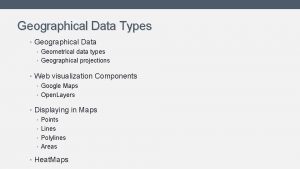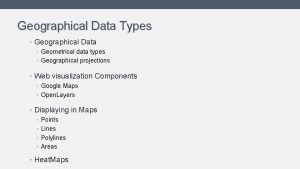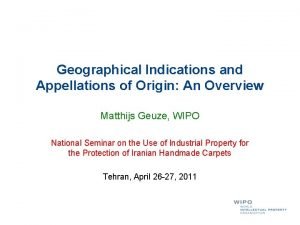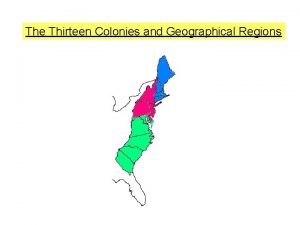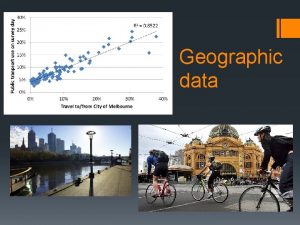Geographic data sources and considerations Geographical Concepts Geographic















- Slides: 15

Geographic data: sources and considerations

Geographical Concepts: • Geographic coordinate system: defines locations on the earth using an angular unit of measure, a prime meridian, and a datum - datum: defines the position of the origin and the orientation of latitude and longitude lines • Map projection: mathematical transformation of the threedimensional surface of the earth into a flat map sheet

Types of spatial data in GIS • Vector data: points, lines, polygons (shapefiles) • Raster data: used in ecological niche modeling for representing environmental conditions (grids) Raster obtained through interpolation Raster obtained through remote sensing Example of interpolated surface from point data using Inverse Distance Weighting technique. Courtesy: Science Applications International Corporation

Characteristics of geographic data • Quality: →Interpolated vs. remotely sensed →Scale at which interpolation was done • Spatial resolution – has to match the scale of the questions we try to address with ENM • Temporal resolution: can represent daily, monthly, annual, or multi-annual averages • Type: categorical vs. continuous (some ecological niche modeling algorithms don't work well with categorical data)

1. Quality: interpolation World. Clim dataset: locations of climate stations with precipitation data - 47, 554 stations World. Clim 1. 4 Mean annual precipitation (1960 -1990) IPPC climate dataset: precipitation data from 19, 800 stations

2. Spatial resolution • size of the cells in the raster IPPC mean annual precipitation 0. 5° resolution World. Clim mean annual precipitation 0. 008° resolution Florida panhandle

3. Temporal resolution • time period averaged (days, months, decades, etc) MODIS EVI 15 -30 October MODIS EVI 30 October-15 November

NASA/GSFC/University of Arizona

Climate projections Mean maximum temperature (1960 -1990) Past climate scenarios (e. g. Pleistocene) Future climate scenarios

4. Type • Categorical data – correspond to discrete fields; the values are assigned to the entire cell area and represent the category number Land cover 2000 • Continuous data – surfaces, used for natural (physical phenomena); the values are assigned to the points and represent the actual measured value Digital elevation model

Points to keep in mind when selecting geographic data for ENM • Temporal and spatial resolution of geographic data has to match those of species occurrence data; also, select a spatial resolution that matches the question asked (e. g. continental spread of an invasive species, vs. predicted distribution of a local endemic species) • Categorical data doesn’t work well with some niche modeling algorithms; it is also difficult to match its temporal resolution with occurrence data • Remotely sensed data is powerful (no interpolation), but can only be used with recent, up to date, species occurrence datasets • When downloading geographic data, pay attention to projection and datum, and any metadata available; some transformations may be necessary

Sources of data • Climatic (Global) data: World. Clim current (1960 -1990) climate data http: //www. worldclim. org/ IPCC current and future climate data http: //www. ipcc-data. org/obs/get_30 yr_means. html http: //www. ipcc-data. org/ddc_climscen. html Climatic Research Unit http: //www. cru. uea. ac. uk/cru/data/hrg. htm Paleoreconstructions PMIP http: //pmip. lsce. ipsl. fr/ NOAA: http: //www. ncdc. noaa. gov/paleo/

Sources of data • Marine data: NOAA World Ocean Atlas http: //www. nodc. noaa. gov/OC 5/indprod. html Climate Prediction Center http: //www. cpc. noaa. gov/products/predictions/30 day/SSTs/sst_clim. html • Topographic and bathymetric: USGS Hydro 1 k http: //edc. usgs. gov/products/elevation/gtopo 30/hydro/ NOAA ETOPO www. ngdc. noaa. gov/mgg/global/seltopo. html Bathymetry http: //ibis. grdl. noaa. gov/cgi-bin/bathy/bath. D. pl

Sources of data • Satellite-derived (free): Global Vegetation Indices: MODIS http: //edcdaac. usgs. gov/dataproducts. asp (EVI and NDVI) 2000 to present AVHRR http: //edcsns 17. cr. usgs. gov/1 KM/1 kmhomepage. html (NDVI): 1985 to present Global Land Cover: IES Global Landcover 2000 http: //www-gvm. jrc. it/glc 2000/ University of Maryland (1992) http: //glcf. umiacs. umd. edu/data/

Other data WWF Ecoregions http: //www. worldwildlife. org/science/data. cfm UNEP IUCN Protected Areas http: //sea. unep-wcmc. org/wdbpa/
 Stage 4 geography syllabus
Stage 4 geography syllabus Print and web sources
Print and web sources Data warehouse considerations
Data warehouse considerations Importance of water management
Importance of water management Nature of geographic data
Nature of geographic data Thematic map ap human geography
Thematic map ap human geography Types of geographical data
Types of geographical data Geographical data types
Geographical data types Essential skills to study geography
Essential skills to study geography Data collection secondary data sources
Data collection secondary data sources Writing strategies and ethical considerations
Writing strategies and ethical considerations Experimental design and ethical considerations
Experimental design and ethical considerations Pricing considerations and approaches
Pricing considerations and approaches Geographical names with and without the
Geographical names with and without the Geographical indication and appellation of origin
Geographical indication and appellation of origin Geographical names with and without the
Geographical names with and without the






